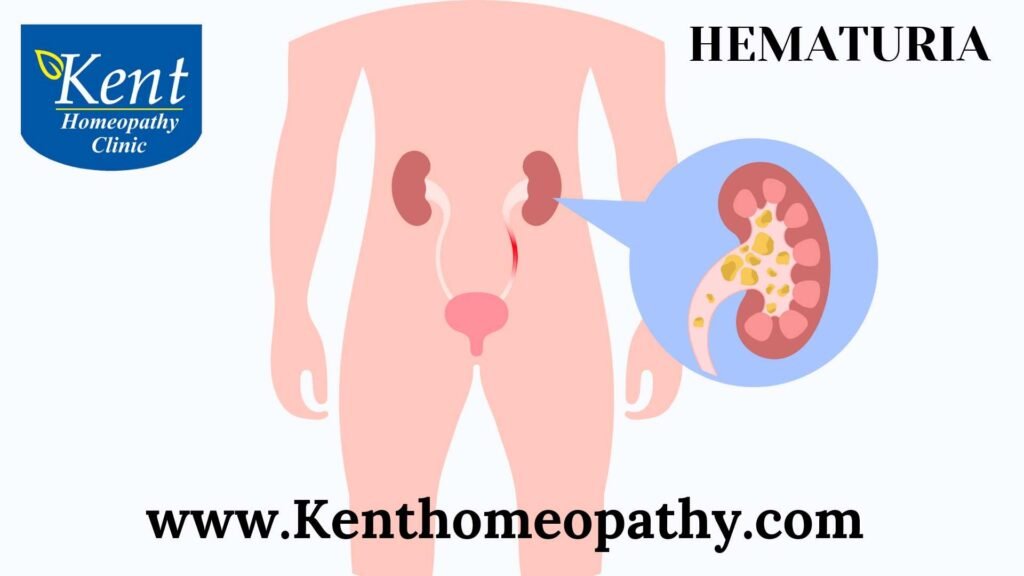Hematuria

Hematuria
Understanding Hematuria: Symptoms, Causes, and Types
Hematuria is a medical term referring to the presence of blood in urine. It can be visible, giving the urine a pink or reddish color, or microscopic, detectable only under a microscope. Hematuria can result from various underlying conditions, ranging from benign to more serious, and understanding its symptoms, causes, and types is crucial for accurate diagnosis and appropriate management.
Symptoms:
The primary symptom of hematuria is the presence of blood in the urine, which may be visible or microscopic. Visible hematuria often gives the urine a pink, red, or brownish color, while microscopic hematuria is only detectable through laboratory testing.
Other symptoms that may accompany hematuria include:
- Pain or Discomfort: Some individuals may experience pain or discomfort during urination.
- Frequent Urination: An increased frequency of urination without an increase in fluid intake may be observed.
- Lower Abdominal Pain: Pain or discomfort in the lower abdominal region may occur.
It’s important to note that hematuria itself is a symptom, not a diagnosis, and further evaluation is needed to determine the underlying cause.
Causes:
- Urinary Tract Infections (UTIs): Infections of the urinary tract, such as cystitis or pyelonephritis, can lead to hematuria.
- Kidney Stones: The presence of kidney stones can cause irritation and bleeding in the urinary tract.
- Trauma: Injury or trauma to the kidneys or bladder may result in hematuria.
- Enlarged Prostate: Benign prostatic hyperplasia (BPH) or prostate inflammation can lead to hematuria in men.
- Bladder or Kidney Infections: Infections affecting the bladder or kidneys may cause hematuria.
- Inherited Disorders: Conditions such as sickle cell anemia or Alport syndrome can be associated with hematuria.
- Blood Disorders: Disorders affecting blood clotting, such as hemophilia, may contribute to hematuria.
- Medications: Certain medications, like blood thinners or specific antibiotics, may cause hematuria as a side effect.
- Irritation or Injury: Chemical irritation or injury to the urinary tract, often related to the use of catheters or certain medical procedures.
- Bladder or Kidney Cancer: Hematuria can be a symptom of bladder or kidney cancer.
Types:
- Gross Hematuria: In this type, blood is visible in the urine, giving it a noticeable color. The severity of the color can range from pink to dark red or brown.
- Microscopic Hematuria: This type is not visible to the naked eye and can only be detected through urine tests. It may be identified during routine check-ups or when investigating other urinary symptoms.
- Transient Hematuria: Temporary or intermittent episodes of hematuria that may resolve on their own. Common causes include vigorous exercise, dehydration, or certain medications.
- Persistent Hematuria: Continuous or recurring episodes of hematuria that may indicate an ongoing or chronic condition requiring further investigation.
Conclusion:
Hematuria is a symptom that warrants careful evaluation to determine its underlying cause. It can result from a wide range of conditions, from urinary tract infections to more serious issues like kidney stones or cancer. Early diagnosis and appropriate treatment are essential for managing the underlying cause and preventing potential complications. If you notice blood in your urine or experience any related symptoms, it’s important to consult with a healthcare professional for a comprehensive assessment and personalized care plan.
Incontinence

Incontinence
Incontinence: Understanding Symptoms, Causes, and Types
Incontinence is a common and often distressing condition characterized by the loss of bladder or bowel control, leading to involuntary leakage of urine or feces. This condition can significantly impact a person’s quality of life and requires careful consideration of its symptoms, causes, and types for effective management.
Symptoms:
- Urinary Incontinence: The most prevalent form, urinary incontinence, involves the unintentional leakage of urine. This can manifest in various ways, including during coughing, sneezing, laughing (stress incontinence), or experiencing a sudden urge to urinate (urge incontinence).
- Fecal Incontinence: This involves the involuntary release of stool. It can range from occasional leakage when passing gas to a complete loss of bowel control.
- Mixed Incontinence: Some individuals experience a combination of both urinary and fecal incontinence, known as mixed incontinence. This often requires a tailored approach to address both aspects.
Causes:
- Muscle Weakness: Weakened pelvic floor muscles, which support the bladder and rectum, can result from factors such as aging, pregnancy, childbirth, or certain medical conditions.
- Nerve Damage: Conditions like diabetes, multiple sclerosis, or injuries affecting the nerves controlling bladder and bowel function can lead to incontinence.
- Hormonal Changes: Women may experience incontinence during menopause due to hormonal fluctuations affecting bladder and pelvic tissues.
- Prostate Issues: Enlarged prostate in men, commonly associated with aging, can cause urinary incontinence.
- Obstruction: Blockages in the urinary or digestive tract can result in incontinence, especially when these obstructions affect normal flow.
- Medications: Some medications, including diuretics, sedatives, and certain antihypertensives, can contribute to incontinence as a side effect.
- Infections: Urinary tract infections (UTIs) or bowel infections can irritate the bladder or rectum, leading to temporary incontinence.
- Physical Impairments: Individuals with mobility issues, such as those with severe arthritis or neurological disorders, may struggle to reach the bathroom in time, contributing to incontinence.
Types:
- Stress Incontinence: This type involves leakage of urine during activities that increase abdominal pressure, such as coughing, sneezing, or lifting. Weakened pelvic floor muscles are often a contributing factor.
- Urge Incontinence: Characterized by a sudden, intense urge to urinate, individuals with urge incontinence may not make it to the bathroom in time, resulting in involuntary leakage. This can be associated with overactive bladder muscles.
- Overflow Incontinence: In cases where the bladder doesn’t empty completely, it may lead to frequent or constant dribbling of urine. This can result from an obstruction, weak bladder muscles, or nerve damage.
- Functional Incontinence: Individuals with physical or cognitive impairments that prevent them from reaching the bathroom in time may experience functional incontinence. This type is often linked to conditions like arthritis, dementia, or mobility issues.
- Mixed Incontinence: As mentioned earlier, mixed incontinence involves a combination of stress and urge incontinence. It requires a multifaceted approach for effective management.
Prostate Cancer

Prostate Cancer
Prostate Cancer: Unraveling Symptoms, Causes, and Types
Prostate cancer is a form of cancer that develops in the prostate, a small walnut-shaped gland in men that produces seminal fluid. It is one of the most common cancers among men, typically occurring in older individuals. Understanding the symptoms, causes, and types of prostate cancer is crucial for early detection and effective management.
Symptoms:
- Urinary Changes:
– Difficulty starting or stopping urination, weak urine stream, or the need to urinate more frequently, especially at night, can be early signs.
- Blood in Urine or Semen:
– Presence of blood in urine or semen may indicate potential issues in the prostate, warranting further investigation.
- Pelvic Discomfort:
– Discomfort or pain in the pelvic area, lower back, or hips can be associated with advanced prostate cancer.
- Erectile Dysfunction:
– Difficulty achieving or maintaining an erection may be linked to prostate cancer, though it can also result from various other factors.
- Unexplained Weight Loss:
– Significant, unexplained weight loss may occur in advanced stages of prostate cancer.
- Bone Pain:
– Spread of prostate cancer to bones can cause bone pain, especially in the spine, hips, or pelvis.
Causes:
- Age:
– The risk of prostate cancer increases with age, with most cases diagnosed in men over 65. Family history and genetic factors also play a role.
- Family History:
– Having a close relative, such as a father or brother, with prostate cancer increases an individual’s risk.
- Race and Ethnicity:
– African-American men have a higher risk of developing prostate cancer, and the cancer may be more aggressive.
- Genetic Factors:
– Inherited gene mutations, such as BRCA1 or BRCA2, known for their association with breast and ovarian cancers, may also increase prostate cancer risk.
- Dietary Factors:
– Some studies suggest a link between a diet high in red meat or high-fat dairy products and an increased risk of prostate cancer. Antioxidants and certain vitamins may have a protective effect.
- Inflammation:
– Chronic inflammation of the prostate (prostatitis) may be associated with an increased risk of prostate cancer.
- Hormonal Influences:
– Hormonal changes, specifically elevated levels of testosterone or the hormone dihydrotestosterone (DHT), may contribute to the development of prostate cancer.
Types:
- Adenocarcinoma:
– The most common type, adenocarcinoma originates in the gland cells of the prostate and may grow slowly. It constitutes the majority of prostate cancer cases.
- Small Cell Carcinoma:
– A rare and aggressive form of prostate cancer, small cell carcinoma tends to grow quickly and may require different treatment approaches.
- Transitional Cell (Urothelial) Cancer:
– Accounting for a small percentage of cases, this type of cancer forms in the cells lining the prostate ducts. It may have different characteristics and treatment considerations.
- Sarcomas, Carcinoid Tumors, and Other Rare Types:
– These types are exceptionally rare, and their characteristics and treatment approaches vary. Sarcomas, for example, develop in the connective tissues of the prostate.
In conclusion, understanding the symptoms, causes, and types of prostate cancer is essential for timely diagnosis and effective treatment. Regular check-ups, screening, and awareness of risk factors play a crucial role in managing this common cancer among men. If there are concerns or symptoms related to prostate health, seeking medical advice promptly is vital for a comprehensive evaluation and appropriate intervention.
Urinary Tract Infections

Urinary Tract Infections
Urinary Tract Infection (UTI): Unravelling Symptoms, Causes, and Types
A urinary tract infection (UTI) is a common condition caused by the invasion of bacteria into the urinary system. UTIs can affect various parts of the urinary tract, leading to a range of symptoms and discomfort. Understanding the symptoms, causes, and types of UTIs is crucial for accurate diagnosis and effective treatment.
Symptoms:
- Painful Urination (Dysuria):
– Dysuria, or pain during urination, is a hallmark symptom of a UTI. It may be described as a burning or stinging sensation.
- Frequent Urination:
– Individuals with a UTI often experience an increased urgency to urinate. Frequent trips to the bathroom may result in small amounts of urine being passed each time.
- Urgency to Urinate:
– An urgent need to urinate, even when the bladder is not full, is a common symptom. This urgency can be disruptive and may be accompanied by discomfort.
- Cloudy or Strong-Smelling Urine:
– Changes in the appearance and odor of urine are common with UTIs. Urine may appear cloudy, and it might have a strong, unpleasant smell.
- Blood in Urine (Hematuria):
– Hematuria, or the presence of blood in the urine, is another potential symptom of a UTI. Blood may give the urine a pink or reddish color.
- Pelvic Pain or Discomfort:
– Some individuals may experience pelvic pain or discomfort, often in the lower abdomen. This can be associated with inflammation in the bladder or other parts of the urinary tract.
- Fatigue and Malaise:
– UTIs can cause general feelings of fatigue and malaise. The body’s immune response to the infection may contribute to overall weakness.
Causes:
- Bacterial Invasion:
– The most common cause of UTIs is the invasion of bacteria into the urinary tract. Escherichia coli (E. coli) bacteria, which normally inhabit the intestines, are a frequent culprit.
- Urinary Tract Obstruction:
– Any obstruction or blockage in the urinary tract, such as kidney stones or an enlarged prostate, can contribute to the development of UTIs by preventing normal urine flow.
- Sexual Activity:
– Sexual activity, especially in women, can introduce bacteria into the urethra, increasing the risk of infection. This is known as honeymoon cystitis.
- Catheter Use:
– Individuals who require urinary catheters for medical reasons are at an increased risk of developing UTIs. The catheter provides a pathway for bacteria to enter the urinary system.
- Weakened Immune System:
– Conditions that weaken the immune system, such as diabetes or HIV, can make individuals more susceptible to infections, including UTIs.
- Menopause:
– Hormonal changes during menopause can alter the environment of the urinary tract, making women more prone to UTIs.
- Voiding Habits:
– Holding urine for extended periods or not fully emptying the bladder during urination can contribute to UTIs by allowing bacteria to multiply in stagnant urine.
Types:
- Cystitis:
– Cystitis is the most common type of UTI, affecting the bladder. Symptoms include frequent urination, urgency, and pain or discomfort during urination.
- Pyelonephritis:
– Pyelonephritis is a UTI that involves the kidneys. It is a more severe and potentially serious infection that can lead to back pain, high fever, and systemic symptoms.
- Urethritis:
– Urethritis is inflammation of the urethra, often caused by infection. It can lead to symptoms such as painful urination and discharge.
- Asymptomatic Bacteriuria:
– Asymptomatic bacteriuria refers to the presence of bacteria in the urine without apparent symptoms. This condition may not cause discomfort but can lead to complications if left untreated, especially in certain populations, such as pregnant women.
- Recurrent UTIs:
– Some individuals experience recurrent UTIs, defined as multiple infections within a specific time frame. Recurrent UTIs may be related to underlying factors such as anatomical abnormalities or persistent risk factors.
Contact to know more
Contact
Timings
Monday to Saturday:
11:00 AM to 02:30 PM
06:30 PM to 09:00 PM
